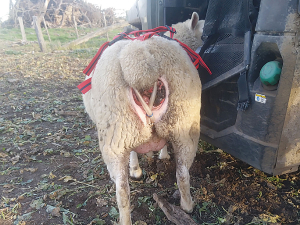Political colours
OPINION: Your old mate welcomes the proposed changes to local government but notes it drew responses that ranged from the reasonable…
 With the bearing out for 3 days and significantly swollen before being put back in, the harness was able to help this ewe through to delivering twins.
With the bearing out for 3 days and significantly swollen before being put back in, the harness was able to help this ewe through to delivering twins.
MPI data shows that 0.5-1% of breeding ewes (around 178,000 nationwide) experience a vaginal prolapse annually. Ian Carr of Rurtec outlines some of the treatment options for bearings...
Section 55B in MPI’s ‘Code of Welfare for Sheep’ states that when a sheep is treated for a uterine or vaginal prolapse, the health and welfare needs of the animal must be met during the procedure and recovery.
This means ensuring a person is available who has suitable equipment. So, you may well ask, what is suitable equipment?
Methods of holding the vulva closed (such as ear tags and sutures) to retain the vagina require judgement on when lambing will occur and when is the best time for removal before lambing.
Plastic T-shaped bearing retainers can be inserted into the vagina and attached to the wool to keep them in place. These can be successful – although placing a foreign body internally induces an innate reaction to expel it. Getting them to stay in place can also be an issue.
The advantage of harnesses is that when the ewe arches to strain, the harness pulls tight to limit the amount of straining while exerting greater pressure against the vulva to hold the bearing in. A harness can be made from baling twine. This can be very effective but reports of the twine cutting into the skin where it passes inside the udder and over the vulva raise a different welfare concern.
In 2016, Rurtec launched a new option, the BEARIN Prolapse Harness.
This harness offers quick and easy fitting, with snap lock buckles and simple strap length adjustment. It incorporates plastic tubing that crosses over the vulva but still allows the clearance of faeces.
And, very importantly, the harness does not need to be removed for lambing as the ewe can easily lamb through or around it.
Encouraged by the uptake of the BEARIN Harness and from further discussion with farmers on other needs at lambing time, Rurtec followed up with the ADLAM Harness three years later.
This is a more versatile harness. Being able to tether the animal after reinserting the bearing also enables checking in an hour or two before release. It can also prevent the ewe racing off as soon as she is released and having the bearing flying out again.
The ADLAM Harness also can be used for standing support for ewes that need it and to restrain ewes for mothering on, preventing the smothering of lambs.
Rurtec prolapse harnesses as very easy to use and effective bearing treatment. Animal welfare does need to be considered in using the harnesses. The ewe must be able to access feed and water while harnessed.
Both ADLAM and BEARIN Harnesses are in stock and ready to help sheep farmers with welfare friendly options for dealing with any bearing issues they face this lambing.

OPINION: Your old mate welcomes the proposed changes to local government but notes it drew responses that ranged from the reasonable…
OPINION: A press release from the oxygen thieves running the hot air symposium on climate change, known as COP30, grabbed your…
An industry-wide project led by Ministry for Primary Industries (MPI) is underway to deal with the rising number of feral…
A Hawke's Bay farming family of self-confessed 'frequent flyers' has donated the proceeds from their spring lambs.
According to Federated Farmers, Environment Southland has mishandled the consent process for Waituna Lagoon, leaving the community with numerous bad…